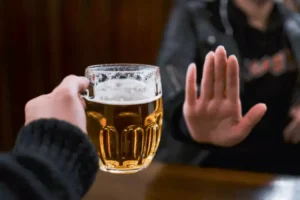
When all their peers are drinking, it can be hard for anyone to say “no.” While fitting in and being socially accepted are extremely important to teens, you can still help them find ways to decline alcohol without feeling left out. Studies have shown that the earlier your child uses alcohol, the more problems they’re likely to experience later in life, so it’s never too early to start the conversation. It can even be easier to have these conversations early on in your child’s adolescent years, when they aren’t as rebellious and are less likely to be have already been exposed to underage drinking.

Teenage Alcoholism: Underage Drinking Facts and Statistics
A National Institute on Drug Abuse (NIDA) study found that just the mere presence of a teenager’s peers could influence their behaviors and encourage them to act in a riskier manner without them even saying https://ecosoberhouse.com/ anything. Teens want to impress their friends, and sometimes, drinking alcohol may seem like the “cool” thing to do. The Monitoring the Future (MTF) survey published by NIDA indicates that in 2016, over half of all high school seniors reported past-year alcohol consumption. Underage drinking can expose teens to a litany of consequences, but there is hope. If your child shows signs of alcoholism, or changes in behavior due to increasing alcohol abuse, contact a treatment provider today.
How to Talk to a Teen about Alcohol
Explain your concerns and make it clear that your fears come from a place of love. Your child needs to feel you are supportive and that they can confide in you, since underage drinking is often triggered by other problem areas in their life. Remember that as a parent, your child is much more likely to mimic your actions than listen to your words. No matter how much you preach about the dangers of underage drinking, if you reach for a drink to unwind at the end of Sobriety a stressful day, your teen may be tempted to follow your example.
- Before talking with your teen, it may be helpful to speak with a healthcare provider who specializes in addiction to obtain guidance.8 They can help walk you through ways to support your teen without blame or lecturing.
- Facts about the societal risk factors for adolescent alcoholism include peer pressure and the portrayal of teen drinking in the media.
- Therefore, healthcare professionals recommend limiting access to alcohol or other drugs, addressing any risk factors of the youth or family, as well as optimal parental supervision and expression regarding expectations.
6. Attrition and missing data
About 3 million deaths worldwide were caused by alcohol consumption alone. The majority of the 273,000 preventable fatalities linked to alcohol consumption are in India 12, which is the leading contributor. According to prevalence studies, 13.1% of drug users in India are under the age of 20 14. Launched in 2012, this five-site consortium recruited a community cohort of 831 diverse adolescents ages 12 to 21 from five U.S. regions (Durham, North Carolina; Palo Alto, California; Pittsburgh, Pennsylvania; Portland, Oregon; and San Diego, California). Half the sample was enriched for key characteristics conveying risk for heavy drinking among adolescents (i.e., family history of substance use disorder, youth externalizing or internalizing symptoms, and having tried alcohol by age 14).
- In therapy sessions, treatment of the adolescentfocuses on building developmental skills, such as decision making,negotiation, and problem-solving skills (Liddle et al., 2001).
- It quickly becomes downright terrifying when, in the mix of it all, a child – a tiny being with a soul and real energy, but a lack of the wisdom of age and a lack of a fully developed pre-frontal lobe – starts using controlled substances.
- There are also different kinds of groups, including those that cater to the teen demographic.
- In addition, the risk of drinking among underage peopleincreases as they get older.
NIDA for Teens: Alcohol
Other studies have shown that alcohol use tends to increase with age during adolescence, with older teens more likely to drink and engage in heavy or binge drinking. In addition to normative social influence on behavior, the friends of an adolescent’s romantic partner may influence opportunities to use alcohol through unstructured socializing. The time that romantic partners spend socializing with their friends may organize adolescents’ own social opportunities in ways that promote alcohol use. If romantic partners include each other in unstructured socializing with their friends, adolescents may find themselves in situations where they are able and encouraged to drink alcohol. To our knowledge, it is unknown whether unstructured socializing involving romantic partners’ friends predicts adolescents’ alcohol use. The bulk of research and interventions has focused on friendships as primary social influences on adolescents’ alcohol use (Brechwald & Prinstein, 2011).
- CBT often includesmotivational interviewing to engage individuals in the treatmentprocess (Liese andNajavits, 1997).
- For females, the estimated coefficients are much smaller than those for males, and for two measures (binge-drinking and drinking frequency), the estimates are actually positive.
- According to the National Institute on Alcohol Abuse and Alcoholism (NIAAA), about 3.4% of US teenagers ages 12 to 17 have AUD.
- Therefore, if someone is a teen or has a loved one who is a teen, it is important to know as much as possible about teenage alcoholism and underage drinking facts.
In that stage, minimizing the risk factors that make a teenager more vulnerable to using alcohol is an issue. The second stage of alcohol and other drug use ranges from experimentation or occasional use to regular weekly use of alcohol, tobacco, inhalants, or other drugs. The third stage involves a youth further increasing the frequency of alcohol use and/or using alcohol and other drugs on a regular basis. This stage may also include the teenager buying alcohol or other drugs or stealing to get their drug of choice.
How can parents prevent teen’s alcohol use?

Moreover, signs of alcoholism include tolerance (needing to drink more in order to get intoxicated), disruption of daily functioning as a result of drinking, withdrawal symptoms when drinking decreases, and a preoccupation with drinking. Watch out for the signs of underage alcohol use in your home and take the pledge teenage alcoholism to Talk It Out with your teen today. Continuing care is crucial to achieving long-term outcomes.Continuing care is often one of the weakest features of adolescenttreatment programs nationwide (Drug Strategies, 2003). Programsshould institute a process of continuing care that includes relapseprevention, training, follow-up plans, referrals to communityresources, and periodic check-ups after completing treatment inorder to help teens avoid recidivism. Each type ofinpatient treatment requires the patient to live temporarily in asafe and controlled treatment facility.

Column (4) adds controls for the use of other substances, which could either be correlates or consequences of alcohol use. Columns (5) and (6) consider other potential mediators of the effects found in (1)-(3) such as days skipped, suspensions from school, and academic difficulties. Participants also reported the name of their current or most recent same-grade boyfriend or girlfriend, if they had any within the past year. Project staff matched these romantic nominations to the names of other participants in the PROSPER study, creating ties between participants. Like friendship ties, romantic ties were based on the single outgoing nomination. Romantic partners’ friends refer to the individuals that a participant’s romantic partner nominated as friends.




